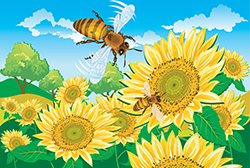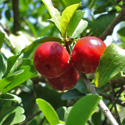Nutritionally Dense Super Foods
For countless thousands of years now, our forefathers sought out the most abundant and nutritious foods they could find.
Sometimes they traveled far to harvest foods that not only sustain them, but also seeking superior quality
wild herbs and plants that was the key to vitality and long life.
As technology evolved and new tools were developed, Agriculture developed about 10,000 BCE
near the coastal areas from Greece to Egypt more than 12,000 years ago. Levant is the name applied to this
region that was the homeland of the Phoenician civilization.
This ancient agricultural area became known as the
Fertile Crescent.
After 9,500 BCE eight important agricultural crops appear:
first emmer and einkorn wheat, then hulled barley, peas, lentils, bitter vetch, chick peas and flax.
These eight crops occur more or less simultaneously on sites in the Levant, although the consensus is that wheat was the first
to be sown and harvested on a significant scale.
Agriculture continued to spread becoming systemized and diversified. By 6000 BCE farming
was prevalent on the fertile banks of the Nile River.
These agricultural lands were very fertile with rich soil nutrients produced high quality crops that were feeding an ancient
industrious empire accomplishing feats of architecture such as pyramids, temples and civilized cities.
Chia seeds were a staple food, like corn and beans, in the diets of the Aztecs and
Mayans dating back to 3500 BC. These ancient people used Chia seeds regularly, grinding them into flour, pressing them for oil and drinking
them mixed with water. Chia seeds were highly prized because of their ability to
increase stamina and energy over long periods of time
delivering the maximum amount of nutrients with minimum calories. Chia is one of the most concentrated sources of omega-3 in any food.
They also contain high amounts of omega-6.
Spelt is an ancient species of wheat known from genetic evidence to have originated as a hybrid of a domesticated
wheat such as emmer wheat and wild goat-grass. The natural hybridization allowed the grain to be adaptable to a wider range of environmental
conditions and requires fewer fertilizers. Because of this it fairs well in organic farming and is making a resurgence in the health food mainstream
as a nutritious super grain, however because of the gluten content would not be for everyone.
Honey and Bee Pollen
 There is no doubt that ancient man thrived on honey and pollen as valuable nutritious food sources in many places of the planet.
Honey bees naturally gather pollen and instinctively resolve which pollen granules are nutritious and wholesome. Honey bee pollen is bio-actively
alive with micronutrients such as vitamins, minerals, carotenoids, bioflavonoids, phytosterols, amino acids, fatty acids, and enzymes.
Bee pollen has been prized since antiquity as a super-nutritious, healthy and a sustainable food source.
This would explain why world class athletes include this superfood in their diet for endurance and performance.
There is no doubt that ancient man thrived on honey and pollen as valuable nutritious food sources in many places of the planet.
Honey bees naturally gather pollen and instinctively resolve which pollen granules are nutritious and wholesome. Honey bee pollen is bio-actively
alive with micronutrients such as vitamins, minerals, carotenoids, bioflavonoids, phytosterols, amino acids, fatty acids, and enzymes.
Bee pollen has been prized since antiquity as a super-nutritious, healthy and a sustainable food source.
This would explain why world class athletes include this superfood in their diet for endurance and performance.
Honey is a highly valued sweet food made by bees using nectar from flowers and was the first and most widespread sweetener
used our ancestors traded extensively throughout the world. Honey contains varying amounts of micronutrients, depending on the type and
quality of the honey that are important to health and nutrition.
 There are specialty types of honey that are considered to be a monofloral variety because the nectar is predominantly from one plant species.
These honeys are relatively pure due to the prodigious nectar production of a particular species of plant. Buckwheat, chestnut, clover blossom,
orange blossom and raspberry are all examples of monofloral honey, each with their own distinctive characteristics, nutritional value and flavors.
Manuka honey comes from the blossoms of the Manuka scrub or
Tea Tree indigenous to New Zealand and Southeast Australia and has antibacterial qualities.
The Australian government has classified Manuka Honey as a Therapeutic Good.
There are specialty types of honey that are considered to be a monofloral variety because the nectar is predominantly from one plant species.
These honeys are relatively pure due to the prodigious nectar production of a particular species of plant. Buckwheat, chestnut, clover blossom,
orange blossom and raspberry are all examples of monofloral honey, each with their own distinctive characteristics, nutritional value and flavors.
Manuka honey comes from the blossoms of the Manuka scrub or
Tea Tree indigenous to New Zealand and Southeast Australia and has antibacterial qualities.
The Australian government has classified Manuka Honey as a Therapeutic Good.
Super-Nutrition is Biodiverse in the Natural World
Since the dawn of humanity there have been abundance of nutritionally superior foods. From the wild harvest of antiquity to modern day
organically grown fruits and vegetables rich in antioxidants, phytonutrients and power packed nutrients we have available to us a variety of
substances to promote health, vitality and longevity. Like our ancestors, it seems natural that we would seek out those foods that have the greatest benefit to us.
New super-fruits, berries and other exotic foods are being discovered and made available to consumers in ever growing numbers.
It is important that sustainable growing and harvesting methods be used. This is especially true for wildcrafted berries, fruits and herbs etc.
We can’t just go in to these limited areas of wild production and harvest all of it expecting we’ll just keep finding new sources.
Sustainable harvesting is the key to having a supply that will be available in the future and ensure economic stability of the crop.
 Here is a good example of a valuable and highly nutritious superfood that is limited to a particular geographical region of the world, and without a
sustainable harvest would cease to be a viable crop.. Camu camu berries grow only in the Amazon rainforest and are one of the world’s
richest sources of naturally occurring vitamin C. The berries actually have up to 60 times more vitamin C than oranges! But these berries
grow only in the most remote areas of the rainforest. As it turns out, the indigenous peoples have been canoeing into these remote parts of the
rainforest for hundreds of years specifically to harvest these precious berries for their own use. If we were to not carefully harvest these super-fruits,
it would not be long before there were no Camu Camu berries to harvest. Additionally the indigenous people would have few berries and
an important economic crop would be gone.
Here is a good example of a valuable and highly nutritious superfood that is limited to a particular geographical region of the world, and without a
sustainable harvest would cease to be a viable crop.. Camu camu berries grow only in the Amazon rainforest and are one of the world’s
richest sources of naturally occurring vitamin C. The berries actually have up to 60 times more vitamin C than oranges! But these berries
grow only in the most remote areas of the rainforest. As it turns out, the indigenous peoples have been canoeing into these remote parts of the
rainforest for hundreds of years specifically to harvest these precious berries for their own use. If we were to not carefully harvest these super-fruits,
it would not be long before there were no Camu Camu berries to harvest. Additionally the indigenous people would have few berries and
an important economic crop would be gone.
Also See:
Marine Phytoplankton is a nutrient dense superfood
Commercially grown crops often are Deficient in Nutrients
There is a big difference between organic whole foods and food that is grown in commercially compromised conditions.
Non organic commercial crops are largely grown in soil that is largely depleted of soil nutrients including minerals,
and is a contributing factor to the nutrient value of the crop.
Chemical fertilizers are added year after year to boost and sustain production. Herbicides and pesticides are sprayed throughout the crops
lifecycle to ensure the successful harvest of the crop. Now we have
genetically modified organisms grown to ensure the success of commercial crops.
We can’t really be led to believe we are producing superior foods under these conditions, especially compared to advanced organic methods.
Of course market demand, pricing, and crop yield all affect the bottom line.
Carefully grown organic foods are more nutritious and have less pesticide and chemical residues than the commercial counterparts.
Proper nutrition is vital to good health and examining the micronutrients found in quantity for superior fruits and vegetables,
leaves little room to doubt the nutritional significance of these foods.
The Importance of Phytonutrients
There are thousands of phytochemicals that are naturally present in plants and algae that constitute a broad spectrum of functions
such as medicines, essential nutrients or chemicals. The health-promoting phytonutrients are accountable for the vibrant colors of our vegetables,
fruits, berries and algae. The colorful oranges, reds, greens and blues of our plant kingdom are all indicators of phytonutrients found in the
huge variety of beneficial plants. There are also the natural antioxidants and bioflavonoids, the active components in healing plants and herbs.
Fruits and vegetables contain phytonutrients. Other common foods also contain phytonutrients, such as Whole grains, Nuts, Beans and Tea.
There are over 25,000 uniquely identified phytonutrients each with their own potential health effects.
There are 600+ carotenoids that produce yellow, orange, and red colors in fruits and vegetables. Probably the most well-known carotenoid is carotene,
found in carrots (also apricots) and are responsible for their bright orange color. Carotenoids act as antioxidants, enhance the vertebrate immune
system and neutralize harmful free radicals that cause cell damage and aging. Carotenoids such as Alpha-carotene, beta-carotene, and
beta-cryptoxanthin can converted to vitamin A to help keep your immune system working properly, and is needed for eye health.
Yellow and orange vegetables like pumpkins and carrots are excellent sources of alpha-carotene, beta-carotene and beta-cryptoxanthin.
Benefits of Superfoods, Organic Fruits and Vegetables
In our modern world we have fast food, pizza, and the ubiquitous use of Fructose. We also are a diseased and overweight modern civilization.
We make choices about our diet and nutrition every day and those choices for many are unhealthy ones. The availability of highly nutritious and
lean food choices abound like never before. There is a cornucopia of organic foods and natural farmer’s markets when in season.
It’s a plain fact that eating a nutritious diet reduces our risk of health problems and gives us vitality. For many of us it is only a matter of choice to
select wholefoods and to avoid processed foods. The good news is that it is not too late for dietary and lifestyle changes that may add years of
quality living and well-being.
It very well may be true that superfoods are the answer for vitality and wellness. At the very least, it should be the norm that we approach
our well-being with a quality nutritious diet and avoid the pitfall of poor dietary choices.